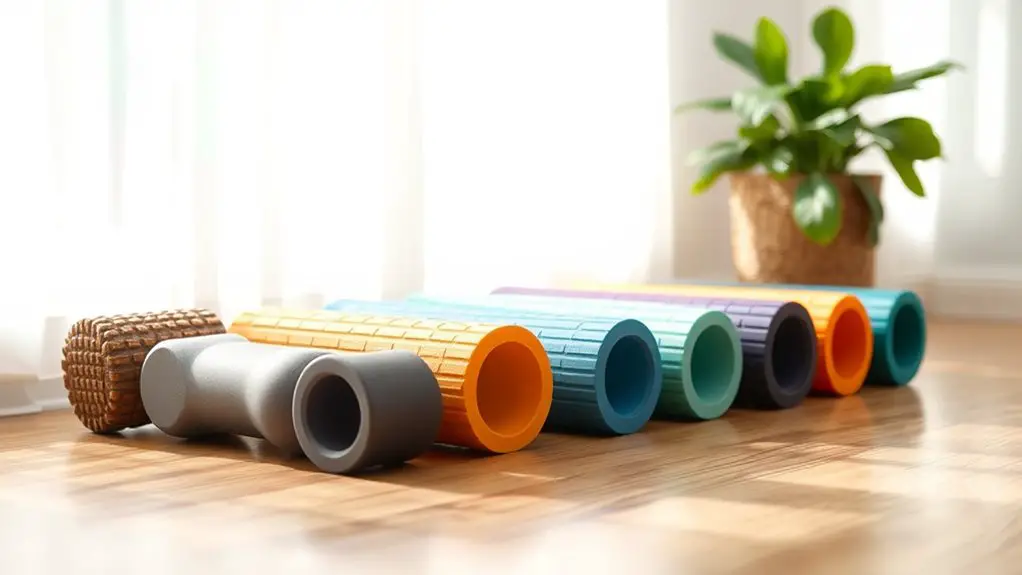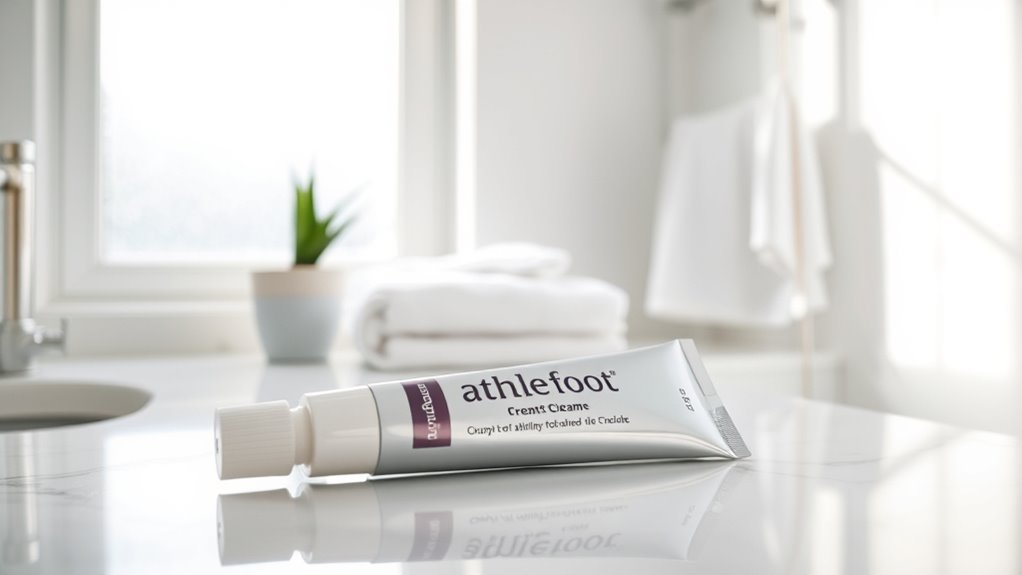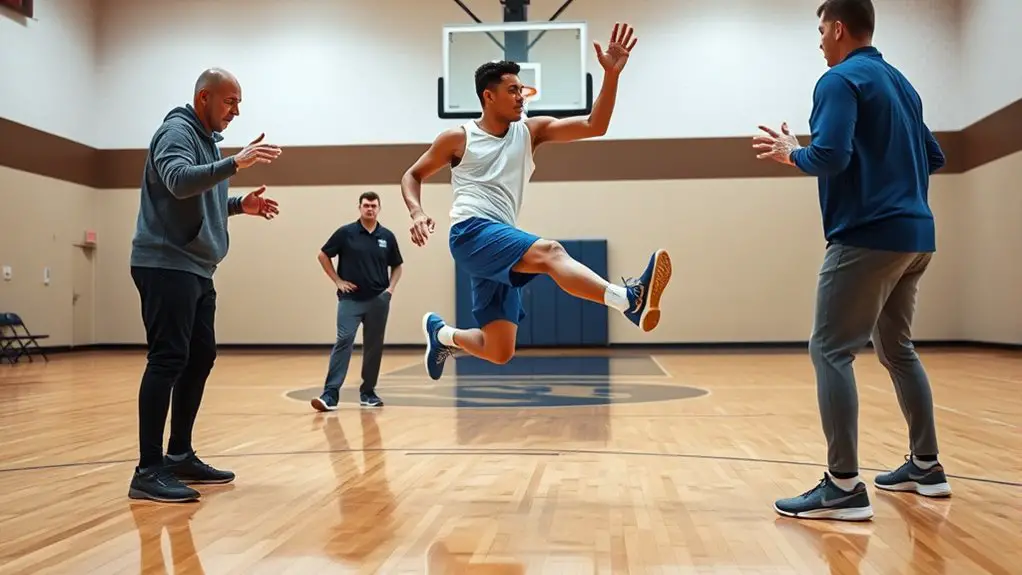When it comes to muscle recovery, foam rollers are essential for relieving soreness and enhancing flexibility. The Rumble Roller and TriggerPoint GRID are great for targeting specific muscle groups, while LuxFit offers a durable choice suitable for all levels. If you want something portable, the ProForm is lightweight and easy to carry. For advanced recovery, try the Hyperice Vyper 2.0, which features vibration technology. Discover more about selecting the right foam roller for your needs!
Understanding Foam Rollers: What You Need to Know
When you think about muscle recovery, foam rollers might not be the first thing that comes to mind, but they play an essential role in alleviating soreness and improving flexibility. These cylindrical tools are designed for self-myofascial release, which means they help release tension in your muscles and connective tissues. Using a foam roller can feel like getting a deep tissue massage without the hefty price tag.
You'll find various types available, from smooth to textured surfaces, each catering to different needs. The key is to choose one that suits your comfort level and desired intensity. Incorporating foam rolling into your routine can enhance your mobility, making you feel more liberated during workouts and daily activities. It's a simple yet effective way to take control of your body's recovery process, allowing you the freedom to move better and feel great. Additionally, regular foam rolling can improve flexibility and help you recover faster from intense workouts. So, why not give it a try?
The Benefits of Foam Rolling for Muscle Recovery
Foam rolling offers a range of benefits that can greatly enhance your muscle recovery process. By incorporating this simple practice into your routine, you'll experience reduced muscle soreness and improved flexibility. It helps break down knots and tight areas in your muscles, allowing for better blood flow and nutrient delivery. This means your muscles can recover faster, so you can get back to doing what you love without feeling held back.
Additionally, foam rolling can enhance your overall performance. As you release tension and improve range of motion, you'll find it easier to tackle your workouts with greater intensity. It's a fantastic way to unwind after a long day or intense training session, giving you that much-deserved sense of relief. So, if you're keen to embrace freedom in your physical activities, foam rolling is an excellent tool for boosting recovery and keeping you moving strong.
Types of Foam Rollers: Which One Is Right for You?
Which type of foam roller should you choose for your needs? Your options can feel overwhelming, but finding the right fit can enhance your muscle recovery. If you're looking for deep tissue relief, a high-density roller is your best bet. It's firmer and targets those stubborn knots effectively. On the other hand, if you're just starting out or prefer a gentler approach, a soft foam roller can ease you into the process.
There are also textured rollers with ridges or bumps that provide varied pressure, perfect for those who enjoy a more dynamic experience. If portability matters to you, consider a compact, travel-friendly option. Ultimately, think about your comfort level and specific recovery goals. Your body deserves the freedom to heal and thrive, so take the time to choose a roller that empowers your journey. Happy rolling!
Top 5 Foam Rollers for Athletes
Finding the right foam roller can make a significant difference in your post-workout routine, especially for athletes. With so many options out there, here are the top five foam rollers that can help you recover faster and keep you moving freely:
- Rumble Roller: Its unique texture targets deep tissue and knots effectively.
- TriggerPoint GRID: This versatile design combines firmness with flexibility, perfect for various muscle groups.
- LuxFit Foam Roller: Great for beginners and experienced athletes alike, it offers a solid, durable option for daily use.
- ProForm Foam Roller: Lightweight and portable, it's ideal for on-the-go recovery after workouts.
- Hyperice Vyper 2.0: This vibrating roller enhances your recovery with its advanced technology, providing an extra edge.
Choose one that fits your needs, and you'll be on your way to a more efficient recovery process, allowing you to focus on what you love—your sport!
Best Foam Rollers for Beginners
Are you new to foam rolling and wondering where to start? It's all about finding the right roller that suits your needs. As a beginner, you'll want something that's not too intense. A softer foam roller is perfect for easing into the practice, allowing you to explore different techniques without overwhelming your muscles.
Look for rollers with a smooth surface; they'll help you get accustomed to the sensation of rolling. The standard 36-inch length is versatile and great for targeting various muscle groups.
Brands like TriggerPoint and LuxFit offer excellent options specifically designed for newbies. They're durable yet gentle, giving you the freedom to roll out tension and promote recovery without pain.
High-Density Foam Rollers: Pros and Cons
While high-density foam rollers can provide a more intense massage experience, they come with their own set of pros and cons. If you're looking to enhance your muscle recovery, consider these points:
- Pros:
- Offers deep tissue relief, perfect for tight muscles.
- Durable and long-lasting, making them a solid investment.
- Provides a firmer surface for targeted pressure.
- Great for advanced users who crave intensity.
- Can help improve flexibility and overall performance.
- Cons:
- Might be too painful for beginners or sensitive areas.
- Heavier and bulkier, making them less portable.
- May require more technique to use effectively.
- Can lead to bruising if not used correctly.
- Higher price point compared to softer options.
Ultimately, if you're ready to embrace the intensity, a high-density foam roller could be your ticket to greater freedom in your fitness journey!
Vibrating Foam Rollers: Are They Worth It?
High-density foam rollers offer a powerful massage experience, but if you're seeking an added edge in muscle recovery, vibrating foam rollers might be worth considering. These innovative tools combine the benefits of traditional foam rolling with the added stimulation of vibrations, which can help release tension in your muscles more effectively.
When you roll on a vibrating foam roller, the vibrations can penetrate deeper into your tissue, promoting blood flow and easing soreness. This means you might recover faster and feel ready to tackle your next workout sooner. Plus, many models let you adjust the intensity, giving you the freedom to customize your experience based on what your body needs. Additionally, incorporating proper nutrition strategies into your recovery routine can further enhance the effectiveness of using a vibrating foam roller.
However, they can be pricier than standard foam rollers, so weigh the potential benefits against your budget. If you're serious about optimizing recovery and enjoying a new level of relief, a vibrating foam roller could be a worthwhile investment in your fitness journey.
Travel-Friendly Foam Rollers for On-the-Go Recovery
When you're on the go, keeping up with your muscle recovery routine can be challenging, but travel-friendly foam rollers make it easier than ever. These compact and lightweight options let you roll out tight muscles anytime, anywhere. Here's what to look for in your next travel foam roller:
- Size: Choose a smaller diameter for easy packing.
- Weight: Opt for lightweight materials that won't weigh you down.
- Durability: Look for high-quality foam that withstands frequent use.
- Design: Consider rollers with handles for added portability.
- Versatility: Pick a roller that targets multiple muscle groups effectively.
With the right travel-friendly foam roller, you can keep your muscles happy while exploring new places. Don't let your recovery take a back seat—grab one that fits your lifestyle and enjoy the freedom of staying on track wherever you go!
How to Use a Foam Roller Effectively
To make the most of your foam roller, it's essential to understand the proper techniques for effective use. Start by targeting specific muscle groups; place the roller under the area you want to work on and slowly roll back and forth. Apply your body weight to feel the pressure, but don't go overboard—pain isn't the goal. Spend about 30 seconds to a minute on each spot, focusing on tight areas.
Remember to breathe deeply; this helps relax your muscles. If you find a particularly sore spot, pause and hold it for 20-30 seconds. You can also mix in different movements, like side-to-side or circular motions, to engage more muscle fibers. Always listen to your body; if something doesn't feel right, stop. Foam rolling should feel relieving, not punishing. Enjoy the freedom that comes with improved mobility and reduced muscle tension!
Maintaining Your Foam Roller for Longevity
A well-maintained foam roller can last you for years, making it a worthwhile investment in your muscle recovery routine. By taking a few simple steps, you can guarantee your roller remains effective and ready for your next session. Here's how to keep it in top shape:
- Clean regularly: Wipe down with a damp cloth and mild soap after each use to prevent dirt buildup.
- Store properly: Keep it in a cool, dry place away from direct sunlight to avoid warping.
- Avoid heavy weights: Don't sit or stand on it when not in use to prevent unwanted damage.
- Check for wear: Inspect your foam roller for cracks or dents and replace it if necessary.
- Rotate usage: If you have multiple rollers, switch them out to distribute wear evenly.
With these tips, you'll enjoy your foam roller for years to come, enhancing your recovery journey!
Frequently Asked Questions
How Often Should I Use a Foam Roller for Best Results?
To release your body's full potential, try rolling for 10-15 minutes, 3-4 times a week. Consistency's key! Listen to your muscles; they'll guide you to when it's time to roll and recover.
Can Foam Rolling Be Beneficial for Non-Athletic Individuals?
Foam rolling can help you release tension, improve circulation, and enhance flexibility, even if you're not an athlete. It's a simple way to promote relaxation and maintain your body's overall well-being. Give it a try!
Is It Safe to Foam Roll Over Injuries or Sore Spots?
Foam rolling over injuries or sore spots can be risky. You should listen to your body; if it hurts, it's best to avoid those areas. Consulting a professional's advice may keep you safe and promote healing.
What Is the Ideal Duration for Foam Rolling Sessions?
Imagine a gentle breeze caressing your skin; that's how foam rolling should feel. For ideal results, aim for 10 to 15 minutes, allowing your muscles to unwind, freeing tension and embracing the movement of freedom.
Can Foam Rolling Replace Other Forms of Muscle Recovery?
Foam rolling's great for muscle recovery, but it shouldn't replace other methods entirely. You'll benefit from a balanced approach, incorporating stretching, hydration, and rest to truly enhance your recovery and maintain your freedom of movement.




